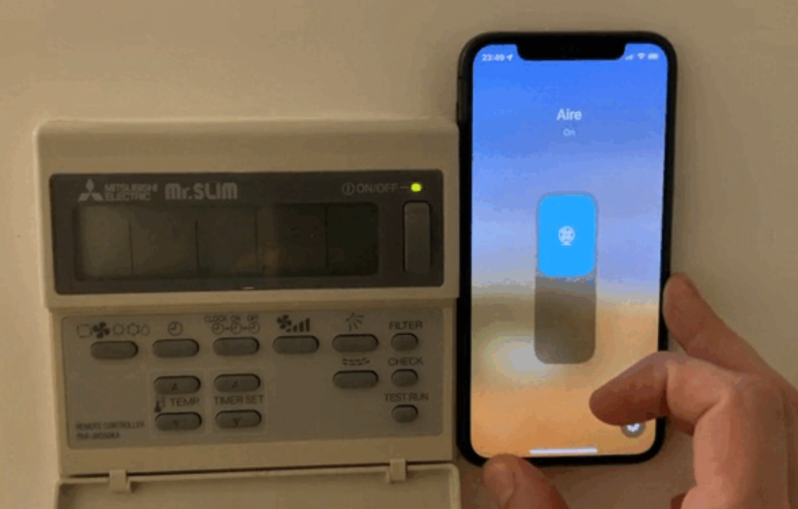Standardization might sound boring, but it’s really a great underlying strength of modern society. Everyone agreeing on a way that a certain task should be done saves a lot of time, energy, and money. But it does take a certain amount of consensus-building, and at the time [JC]’s HVAC system was built the manufacturers still hadn’t agreed on a standard control scheme for these machines yet. But with a little ingenuity and an Arduino, the old HVAC system can be given a bit of automatic control.
The original plan for this antiquated system, once off-the-shelf solutions were found to be incompatible, was to build an interface for the remote control. But this was going to be overly invasive and complex. Although the unit doesn’t have a standard remote control system, it does have extensive documentation so [JC] was able to build a relay module for it fairly easily with an Arduino Nano Matter to control everything and provide WiFi functionality. It also reports the current status of the unit and interfaces with the home automation system.
While some sleuthing was still needed to trace down some of the circuitry of the board to make sure everything was wired up properly, this was a much more effective and straightforward (not to mention inexpensive) way of bringing his aging HVAC system into the modern connected world even through its non-standardized protocols. And, although agreeing on standards can sometimes be difficult, they can also be powerful tools once we all agree on them.
















Mitsubishi! The Tri-Diamond! We had some rebranded 286s sold by Burroghs/UniSys but the name and emblem were all over the inside – same as the Leading Edge Model D2. Sturdy and reliable! Which was saying something in “smoke in the office Era”
Honestly, HVAC systems are dead easy to work on anyway. The older they are, the less complexity they already have built in. So adding your own complexity is easier because you don’t need to understand anyone else’s complexity first.
Document well so the new house owner can deal with it.
When I move I’m taking out all the home automation stuff. Muggles don’t understand it.
Or at best, muggles just want an Alexa to talk to. SMH.
In case of “hit by a truck” all my HA kit works via IP or via the manual controls you’d expect in a standard house.
Family just need to remove one server and all automation dies with me – as they requested.
>I don’t care about the HVAC’s errors
I used to have that attitude when building my DIY smarthome. I know better now. Error notifications are awesome. Nothing like knowing when there’s trouble before you have to find out the hard way.
Aside from that, good project. But as you’re putting that microcontroller in there anyway, it’s really a bit too lazy for my taste not tapping into the error output. It’s *right there* for the taking :-D
Next article how to make system offline.
Just a heads up to check your home insurance policy, as many prohibit and/or become void if there is installation of primary HVAC control systems that are not formally approved. In other words, should the system fail during very cold conditions causing the water pipes to freeze/burst… then you could be without any insurance to cover any losses or costs to repair.
IANAL but it seems like the primary control system is still the Mitsubishi panel and this simply allows the user to toggle the system on/off remotely
The policy exists for a reason, but understanding the reason may help to safely work around it.
HVAC systems are often built down to a price such that they have constraints having to do with pressures and temperature and stuff, plus there’s certain things you can’t run at the same time and certain important timings for starting things up. Getting it wrong can break your system or wear it out or even start a house fire, depending on what equipment is installed and how you screw it up. And the enforcement for keeping it all managed was traditionally located in the thermostat. It shouldn’t be (and on newer systems it probably isn’t), but it definitely was originally.
So an “unapproved” thermostat might not enforce the right rules, it’s like modding your HVAC system itself. But… if you work only within the thermostat’s publicly exposed interface (ie: pushing button and reading the display) then the thermostat is still enforcing the rules.
The catch is that if you solder to the thermostat then you’re modifying it in a way that could be interpreted as a violation of your policy, so the “how” matters.
…to be clear, the more serious constraints with the highest related danger, like blower motor timing and stuff, are PROBABLY enforced by the unit itself with appropriate failsafes and stuff on anything even remotely modern. Product safety liability lawsuit are a thing. And the rules enforced by third party thermostats like Nest are pretty simple, mostly to do with keeping the oldest units from killing themselves on startup.
But the thermostat is technically part of the HVAC unit and can be blamed for a fault, so it’s subject to all the same product liability insurance expectations. Which is a big part of why thermostats cost so damn much for how cheap they otherwise are to make and sell.
It sounds like all they need to do to remove it, is to disconnect two wires. Easy enough to do before the insurance investigators come round.
The cn51 connector is available on most Mitsubishi aircon units. I have used it for a lot of external controls. Many schools like to have simple push to run for 2 hours with the remotes not accessible to tampering by students or teachers.